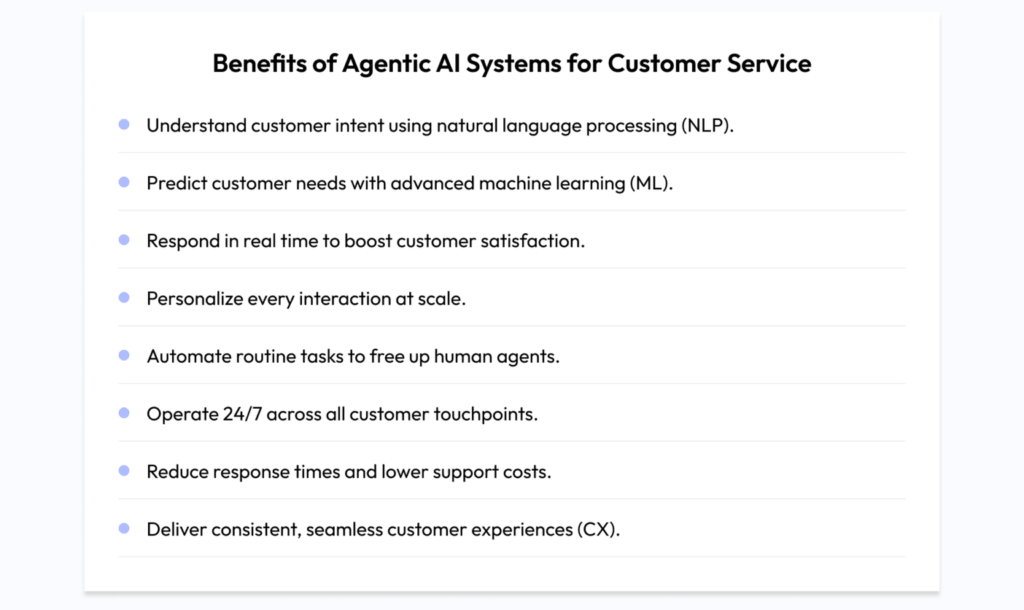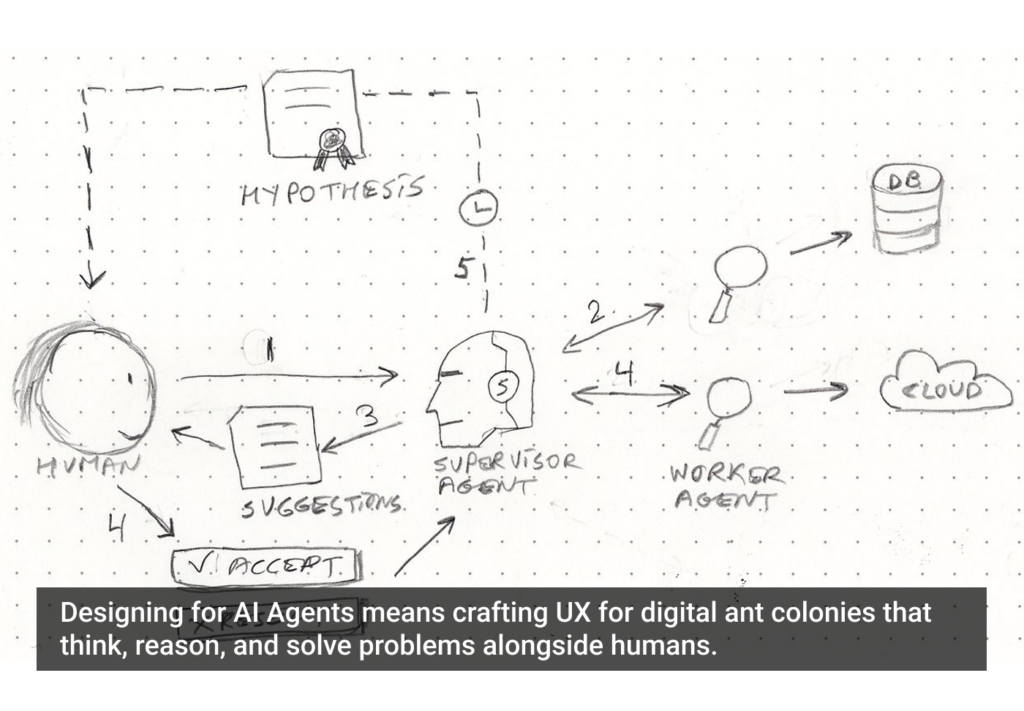The race to redefine customer experience (CX) is accelerating. As customer expectations continue to rise, businesses are under increasing pressure to deliver faster, smarter, and more personalized interactions. According to Salesforce1, 80% of customers say the experience a company provides is just as important as its products, while 73% demand better personalization.
Forrester’s 2024 US Customer Experience Index2 revealed that only 3% of companies are truly “customer-obsessed,” yet those that are reap substantial financial rewards, including 41% faster revenue growth and 49% faster profit growth.
So, how can businesses meet evolving customer demands and enhance CX? Agentic AI enables companies to create seamless, autonomous customer interactions that not only improve response times but also tailor experiences to individual preferences. From data-driven personalization to the rise of hybrid AI systems, agentic AI is reshaping how brands engage with their customers.
As Jeff Bezos, founder and former CEO of Amazon, said:
“The transformative potential of AI is unmatched. AI is an enabling layer that can be used to improve everything. It will be in everything.”
In this blog post, we delve into how agentic AI technology is driving customer satisfaction and giving companies the competitive edge they need to thrive.
Agentic AI is transforming customer service
Agentic AI refers to intelligent systems capable of autonomously carrying out tasks and making decisions without direct human intervention. In customer service, agentic AI is transforming how businesses interact with their customers by providing fast, personalized, and seamless experiences. According to Gartner3, by 2029, agentic AI will autonomously resolve 80% of common customer service issues without human intervention, leading to a 30% reduction in operational costs.
By utilizing advanced machine learning (ML) models and natural language processing (NLP), agentic AI systems can:
- Understand customer queries,
- Predict their needs, and
- Respond in real-time, improving response times.

With agentic AI-driven solutions, organizations can not only automate routine tasks but also personalize every interaction, tailoring responses based on individual customer preferences and behaviors. For example, AI can analyze past interactions, purchase histories, and browsing patterns to offer relevant recommendations or solutions. This level of personalization was once the domain of human agents but is now scalable across millions of customer touchpoints.
Furthermore, businesses are increasingly integrating hybrid AI systems — combining cloud-based and on-premises agentic AI solutions — to enhance security, control data, and improve the accuracy of decision-making.
This shift from traditional, reactive customer service models to proactive, AI-powered systems is reshaping the landscape of customer service, allowing companies to deliver exceptional and consistent experiences across all channels. As a result, agentic AI not only accelerates operational efficiency but also fosters deeper customer relationships.
“Just like lean manufacturing helped industrial companies grow by increasing value and reducing waste, AI can do the same for knowledge work. For us, AI is already driving significant savings in the customer service segment. We spend about $4 billion annually on support from Xbox and Azure. It is improving front-end deflection rates and enhancing agent efficiency, leading to happier customers and lower costs.”
— said Satya Nadella, CEO of Microsoft.
Real-world impact: how leading brands are using agentic AI
Data-driven personalization
Agentic AI is changing how brands personalize their customer experiences. For example, companies like Sephora4 and Starbucks use AI to analyze customer data — such as purchase history, browsing behavior, and preferences — to deliver hyper-personalized recommendations and marketing. Starbucks, in turn, employs its AI-driven system, Deep Brew5, to customize offers and optimize store operations. Similarly, Netflix leverages AI and machine learning6 to personalize content recommendations, thumbnails, and even promotional trailers based on individual viewing habits and preferences. With AI-based tailored experiences, brands can build deeper loyalty and make every interaction feel uniquely relevant to the customer.
Improving response time
Agentic AI also plays a vital role in improving operational efficiency through real-time responsiveness. Financial institutions like JPMorgan Chase use AI to monitor transactions instantly7, enabling faster fraud detection and resolution. In the retail sector, Walmart uses AI to track inventory in real time8, ensuring products are available when and where customers need them. Such Agentic AI systems allow companies to respond to issues proactively, leading to faster resolutions and higher customer satisfaction.
AI and human collaboration
Rather than replacing human agents, agentic AI is enhancing their capabilities. H&M, for instance, combines AI-powered chatbots with human customer service agents9 to streamline support across digital platforms. The AI handles routine questions — like order tracking and return policies — while complex or sensitive issues are seamlessly escalated to human staff. Commonwealth Bank of Australia10 follows a similar model, using AI to resolve routine banking questions, freeing up human agents to focus on complex customer needs.
“AI allows us to deliver better experiences to more customers at a faster rate, and we’re already seeing significant benefits in a variety of use cases.”
— said Matt Comyn, CBA CEO.
Beyond efficiency: ethical considerations and the future of human-AI collaboration
As agentic AI becomes more deeply embedded in customer service strategies, it’s no longer just about speed and scale — it’s also about responsibility. Ethical concerns, particularly around data privacy and transparency, are taking center stage. Customers are sharing vast amounts of personal information, often without fully realizing it. This makes it critical for businesses to use AI responsibly:
- collecting data transparently,
- safeguarding it diligently, and
- clearly informing users how it’s being used.
It’s still important to maintain the option for customers to speak with a human when needed, especially in sensitive or high-stakes situations.
As Marco Iansiti, Harvard Business School professor and co-instructor of the online course AI Essentials for Business with HBS Professor Karim Lakhani, says:
“We need to go back and think about that a little bit because it’s becoming very fundamental to a whole new generation of leaders across both small and large firms. The extent to which, as these firms drive this immense scale, scope, and learning, there are all kinds of really important ethical considerations that need to be part of the management, the leadership philosophy from the get-go.”

Looking ahead, the future of AI-based customer service lies not in replacing human agents but in empowering them. AI agents can take on the repetitive, routine inquiries, freeing up human representatives to focus on more complex, emotional, or strategic interactions. This hybrid model enhances productivity and also helps reduce burnout among support staff.
However, as Agentic AI continues to evolve, businesses must be intentional about how they scale its use, ensuring that automation is balanced with empathy, and innovation with integrity. Ethical guidelines are crucial in this process, as seen in documents like UNESCO’s Recommendation on the Ethics of Artificial Intelligence (2021)11, the United Nations’ Principles for the Ethical Use of Artificial Intelligence (2022)12, and the Council of Europe Framework Convention on Artificial Intelligence (2024)13. These reports emphasize the need for transparency, fairness, and accountability in AI systems, urging businesses to prioritize responsible AI use while safeguarding customer privacy and rights.
By adhering to such ethical frameworks, companies can not only optimize customer experience but also foster long-term trust and loyalty in an increasingly automated world.
The road ahead: embracing AI for a better customer experience
At the Konsulteer (a global analyst firm focused on Data, AI, and Enterprise Applications) webinar, “Agentic AI in 2025: Adoption Trends, Challenges, & Opportunities,” it was highlighted that customer service and support is the top initial use case for agentic AI, with 78% of companies considering it for pilot projects.
As agentic AI reshapes customer service, its ability to enhance response times, deliver hyper-personalized experiences, and elevate satisfaction is transforming industries, and its role in crafting dynamic, tailored customer experiences will only grow.
- 1What Are Customer Expectations, and How Have They Changed? (Salesforce)
- 2Forrester’s 2024 US Customer Experience Index
- 3Gartner Predicts Agentic AI Will Autonomously Resolve 80% of Common Customer Service Issues Without Human Intervention by 2029
- 4Case Study: Sephora’s Use of AI to Deliver Personalized Beauty Experiences
- 5Deep Brew: Transforming Starbucks into an AI & data-driven company
- 6Case Study: How Netflix Uses AI to Personalize Content Recommendations and Improve Digital Marketing
- 7How AI will make payments more efficient and reduce fraud
- 8How Walmart Uses AI to Optimize Inventory Management
- 9How H&M Uses AI-Powered Chatbots to Improve Customer Service
- 10Customer safety, convenience, and recognition boosted by the early implementation of Gen AI
- 11UNESCO’s Recommendation on the Ethics of Artificial Intelligence (2021)
- 12United Nations’ Principles for the Ethical Use of Artificial Intelligence (2022)
- 13Council of Europe Framework Convention on Artificial Intelligence (2024)
The article originally appeared on OneReach.ai.
Featured image courtesy: Alex Sherstnev.








